It looks like you're using an Ad Blocker.
Please white-list or disable AboveTopSecret.com in your ad-blocking tool.
Thank you.
Some features of ATS will be disabled while you continue to use an ad-blocker.
21
share:
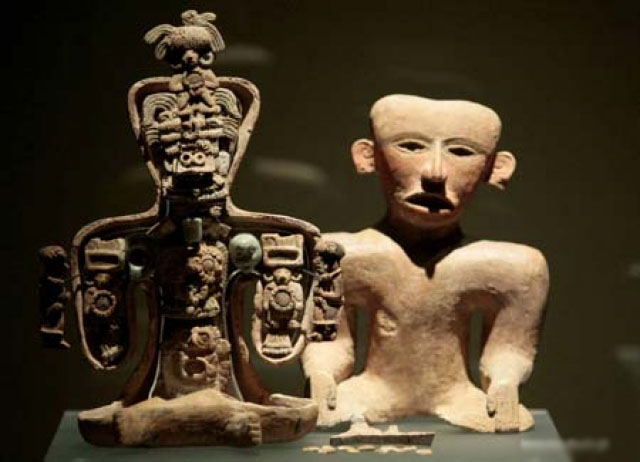
A very interesting class of figurines from Teotihuacán which sort of defy explanation;
These unusual figures from the great ancient Mexican city of Teotihuacán - revered by the Aztecs/Mexica and called by them the ‘City of Gods’ - present something of a mystery: what exactly did they signify? They appear to have puzzled scholars since the first one, from Metepec, was found by George Vaillant in 1933
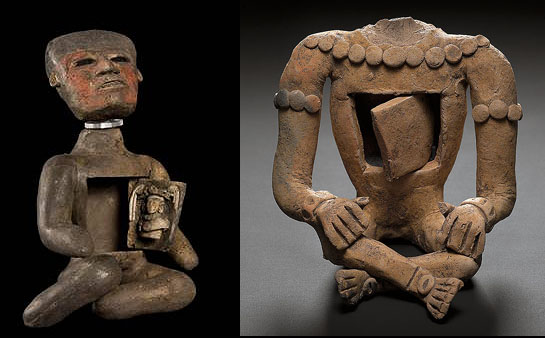
Dubbed figura huésped or ‘host figurine’ in Spanish - as they ‘host’ varying numbers of smaller, solid figurines inside them - these two-part, relatively naked clay figures, found in burials and offerings as far away from Teotihuacán as Guatemala, Michoacán and the Yucatán, have prompted experts to suggest a number of possible meanings:-
• Fertility, nurturing and growth (Note though that host figurines are just as often male as female!)
• The concept of the nahual - our inner self, companion spirit, double
• An earth deity receiving and protecting the souls of dead warriors
• The multi-ethnic make-up of a city like Teotihuacán:
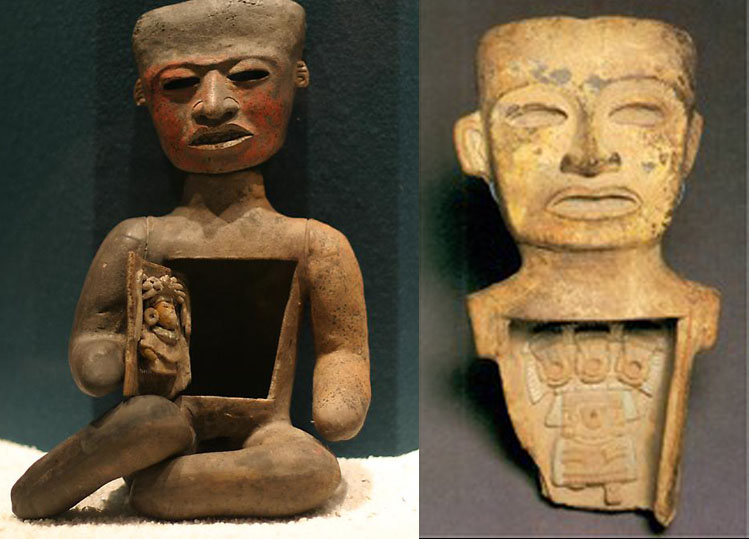
I think it's reasonable to suggest the figurines are 'God Powered' in some sense, as these relate to their inner workings, but as a class of creatures in themselves they appear neither to be Gods nor human, and they always appear to be masked.
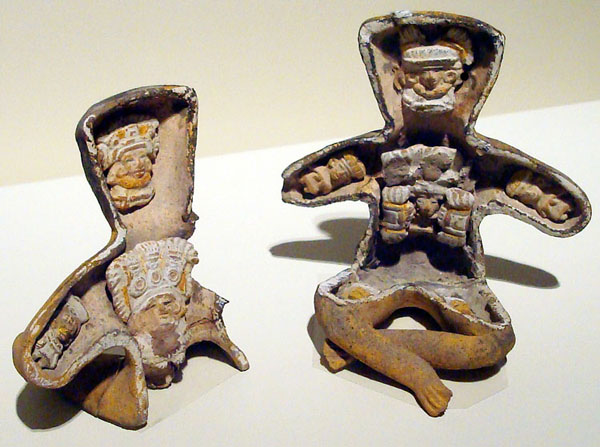
It looks in some sense what one might expect an ancient people to have come up with if they had encountered a robotic automaton and seen the complex internal workings and understood this as somehow being powered by the Gods, who must therefore in some sense be inside it.
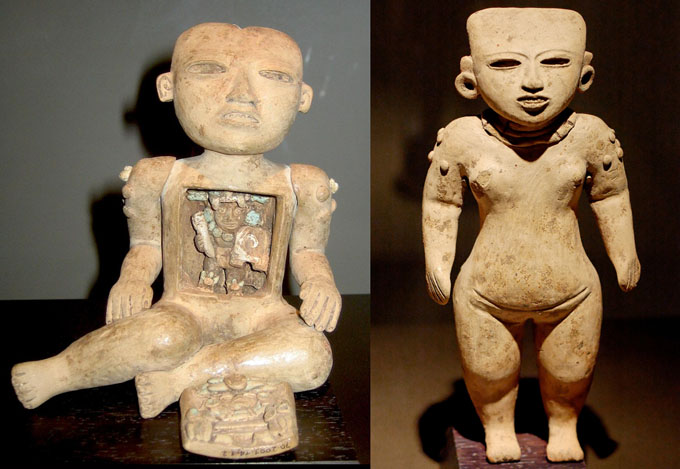
So very curious little figurines and there's no given correct explanation for them so i wonder what others might suggest?
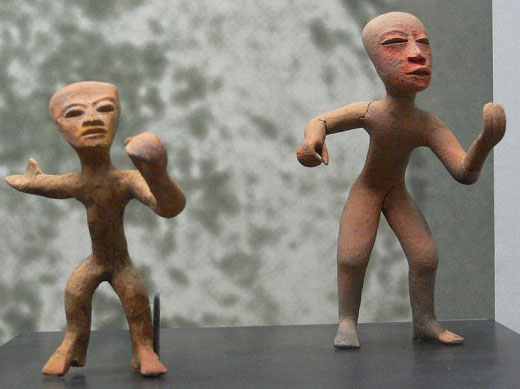
Host Figurines
It could be the most obvious one, the inner anatomy of humans.
I mean, they hunt and slaughter animals and in war humans, so they know that the inside of humans and animals have a function, they then use their own language which is depictions of faces gods and symbols to show the meaning of the hearts, lungs and other stuff that keeps us alive, like a doctors tool...
I mean, they hunt and slaughter animals and in war humans, so they know that the inside of humans and animals have a function, they then use their own language which is depictions of faces gods and symbols to show the meaning of the hearts, lungs and other stuff that keeps us alive, like a doctors tool...
a reply to: Mianeye
Well my Mother did always tell me that i was born by opening a little door in her back and just stepping out when i was younger, but i never sort of believed that!
There are also a lot of similar puppet figurines and perhaps they might give insight into figures controlled by unseen hands?
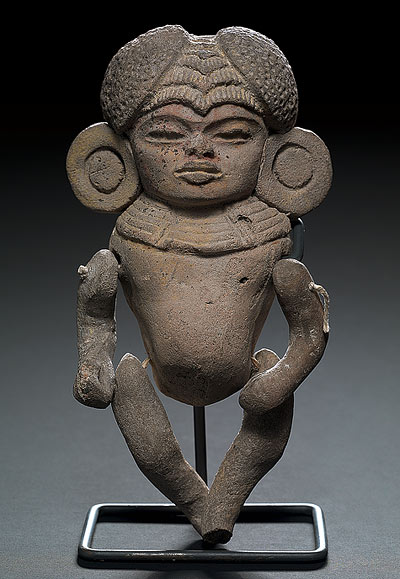
Well my Mother did always tell me that i was born by opening a little door in her back and just stepping out when i was younger, but i never sort of believed that!
There are also a lot of similar puppet figurines and perhaps they might give insight into figures controlled by unseen hands?

a reply to: Kantzveldt
These remind me of a scene in the Stargate Movie, when the first stargate team unmasks one of Apophis's guards, and shows the native inhabitants they are not gods under their masks.
Especially the first and fourth images.
ETA: Oops. That was RA, not Apophis.
These remind me of a scene in the Stargate Movie, when the first stargate team unmasks one of Apophis's guards, and shows the native inhabitants they are not gods under their masks.
Especially the first and fourth images.
ETA: Oops. That was RA, not Apophis.
edit on 7/28/2014 by Klassified because: add
edit on 7/28/2014 by Klassified because: eta
a reply to: Kantzveldt
The first image does look like a robot/atomaton.
But the others-could they have played a role in the training of priests in order for them to know where the heart is located for more effeicient sacrifice?
Sort of like how surgeons train by using models these days?
The first image does look like a robot/atomaton.
But the others-could they have played a role in the training of priests in order for them to know where the heart is located for more effeicient sacrifice?
Sort of like how surgeons train by using models these days?
a reply to: Klassified
Yes i just imagine this scene of these little critters running around the Mexican jungle scaring the natives until they finally manage to catch one and discover it's a mechanical puppet of some higher force, would be a great movie
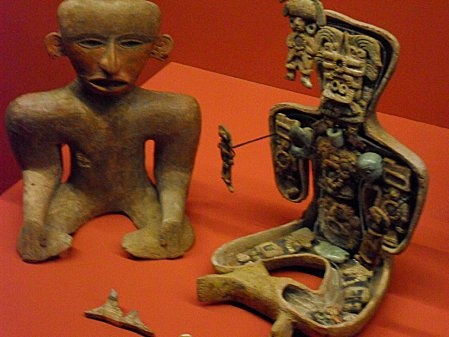
a reply to: Silcone Synapse
They don't really seem like any sort of reasonable re-construction of the internal organs, they were burial offerings so perhaps they were expected to serve some useful function in the afterlife on behalf of the deceased, rather like the Egyptian shabti figurines.
Yes i just imagine this scene of these little critters running around the Mexican jungle scaring the natives until they finally manage to catch one and discover it's a mechanical puppet of some higher force, would be a great movie

a reply to: Silcone Synapse
They don't really seem like any sort of reasonable re-construction of the internal organs, they were burial offerings so perhaps they were expected to serve some useful function in the afterlife on behalf of the deceased, rather like the Egyptian shabti figurines.
edit on
Kam731208vAmerica/ChicagoMonday2831 by Kantzveldt because: (no reason given)
a reply to: Kantzveldt
Interesting share Kantzveldt . When observing these figurines some of them appear to be showing interior workings of some form of suits. As if the natives found some of the "remaining or left" materials from the Visit...
Visit comes to mind every time I see this image
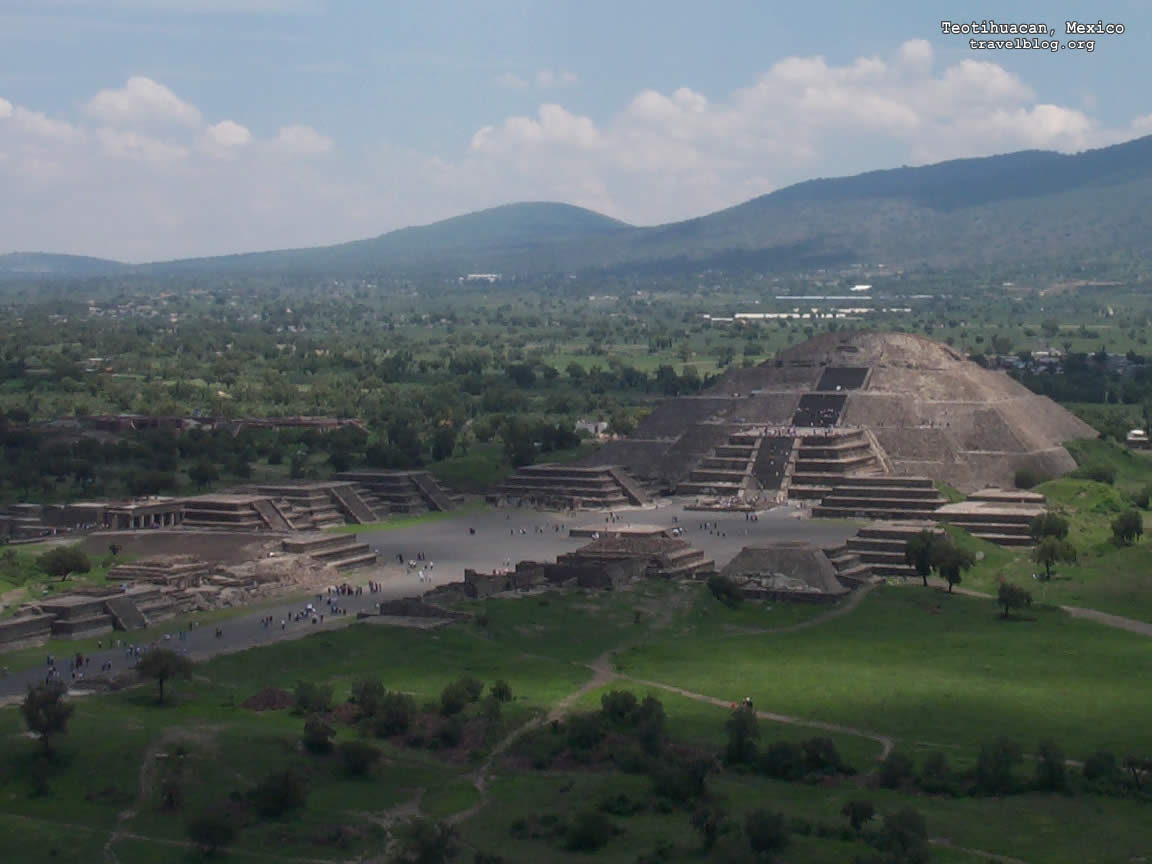
And so maybe these are "worker" suits used by some who came and built... The interiors look kind of mechanical. Would be odd if some of the suits were large enough to fit multiple members within some of them for construction purposes...
NAMASTE*******
Interesting share Kantzveldt . When observing these figurines some of them appear to be showing interior workings of some form of suits. As if the natives found some of the "remaining or left" materials from the Visit...
Visit comes to mind every time I see this image

And so maybe these are "worker" suits used by some who came and built... The interiors look kind of mechanical. Would be odd if some of the suits were large enough to fit multiple members within some of them for construction purposes...
NAMASTE*******
I'm going with the nahual, or inner beings... Who could at the same time be outside.
www.abovetopsecret.com...
There is a theory that melanin and dark matter (or cosmic melanin) are somehow connected, creating a kind of celestial /biological doorway.
These figures to me depict "this side" of the door, or at least how we might describe it.
Host figurines?
A kind of (divine) possession. (Depending how you read it )
www.abovetopsecret.com...
There is a theory that melanin and dark matter (or cosmic melanin) are somehow connected, creating a kind of celestial /biological doorway.
"melanin is the physical manifestation of the entire electro magnetic spectrum, so that means that where ever you are, any light that is like you, your melanin is going to be able to pick that up and relay it to your brain because every granule of melanin is directly sitting on a nerve ending, because it is a neuron, it is a form of brain tissue. so if you happen to be jet black, and you are walking around outside, and there is a particular star that is up in the sky, the amount of light that is being pulsated from this particular star will actually hit your melanin granules, your nerves will then relay that to the brain, and it will make an image!" -jewel pookrum
These figures to me depict "this side" of the door, or at least how we might describe it.
Host figurines?
A kind of (divine) possession. (Depending how you read it )
edit on 28-7-2014 by Wifibrains because: (no reason given)
Symbols showing which god has 'domain' over that part of the body
a reply to: Ophiuchus 13
Interesting! I had a similar theory... Only it wasn't a visit, but a kind of magic or science perhaps?
(Building pyramids with giants and fohat)
www.abovetopsecret.com...
These figurines would fit in that thread nicely also if the same methods were used for building pyramids in South America.
Hmmm.
And so maybe these are "worker" suits used by some who came and built... The interiors look kind of mechanical. Would be odd if some of the suits were large enough to fit multiple members within some of them for construction purposes...
Interesting! I had a similar theory... Only it wasn't a visit, but a kind of magic or science perhaps?
(Building pyramids with giants and fohat)
www.abovetopsecret.com...
These figurines would fit in that thread nicely also if the same methods were used for building pyramids in South America.
Hmmm.
a reply to: Wifibrains
I think there is some sense that what is seen inside is what was understood to animate these creatures, ie the Divine representations, i don't think they're human but imitate such, through the mask, and again that they are puppets of higher intelligence but which can be helpful particularly in the afterlife were they are able to function effectively as they're not really alive in the first place...
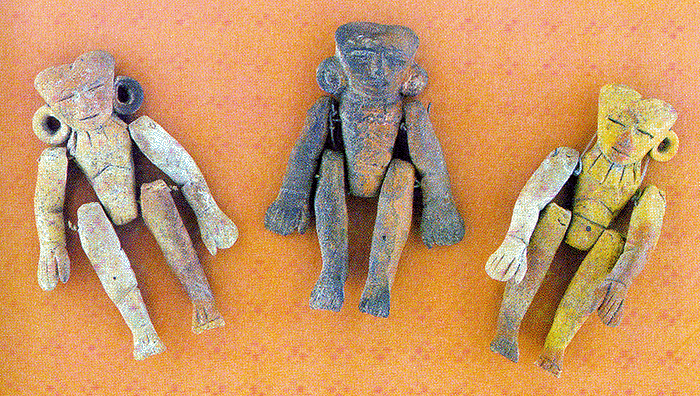
a reply to: Ophiuchus 13
Yes if they'd seen the inside of an automaton and then tried to reproduce the visual impression i fancy they'd have come up with something along these lines.
I think there is some sense that what is seen inside is what was understood to animate these creatures, ie the Divine representations, i don't think they're human but imitate such, through the mask, and again that they are puppets of higher intelligence but which can be helpful particularly in the afterlife were they are able to function effectively as they're not really alive in the first place...

a reply to: Ophiuchus 13
Yes if they'd seen the inside of an automaton and then tried to reproduce the visual impression i fancy they'd have come up with something along these lines.
edit on Kpm731208vAmerica/ChicagoMonday2831 by Kantzveldt because: (no reason given)
a reply to: Wifibrains
Nephilim (giant) builders or this
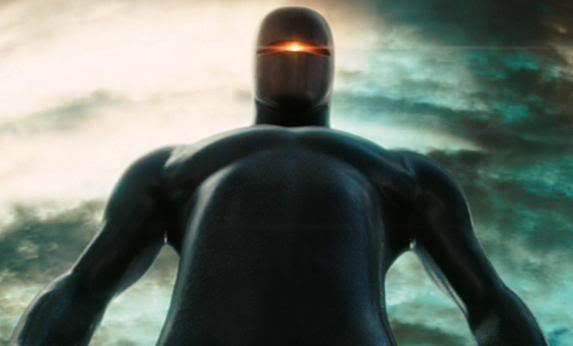
comes to mind after taking a look @ your op.
a reply to: Kantzveldt
Makes 1 wonder why today large size like builder/constructors haven't been constructed on EA*RTH to construct large builds... Would be combination of the dump truck/excavator/cranes/ and maybe even material carriers.
Nephilim (giant) builders or this

comes to mind after taking a look @ your op.
a reply to: Kantzveldt
Makes 1 wonder why today large size like builder/constructors haven't been constructed on EA*RTH to construct large builds... Would be combination of the dump truck/excavator/cranes/ and maybe even material carriers.
edit on 7/28/14 by Ophiuchus 13 because: (no reason given)
a reply to: Ophiuchus 13
They remind me also of some of the conjecture associated with Teraphim,as animated idols able to communicate;
Talking Teraphim
Mystery of the Teraphim
All very speculative there, but there was the tradition that developed of communicating with the stars through Teraphim.
And some make them in the figures of men, of gold and silver, and go to them in times known to them, and the figures receive the influence of the stars, and tell them future things, and in this manner were the images which Rachel stole from her father (Jasher 31:43).
They remind me also of some of the conjecture associated with Teraphim,as animated idols able to communicate;
When the kings of Mesopotamia were away from their home city, particularly when they were afield on one of their numerous military expeditions, they required some sort of mobile or portable communications to keep in touch with their home base and to receive instructions from the gods. For this purpose they took with them the temple images or statues of the gods. These statuettes were believed to be the active residence of the deity. They were of different size and composition. Joan Oates in her definitive work Babylon, remarks that these animated statues which were carried off to war by the kings and priests, were fashioned and repaired in special workshops in the city and had to undergo an elaborate and highly secret ritual of consecration which endowed them with "life," and enabled them to speak.
Talking Teraphim
Mystery of the Teraphim
All very speculative there, but there was the tradition that developed of communicating with the stars through Teraphim.
And some make them in the figures of men, of gold and silver, and go to them in times known to them, and the figures receive the influence of the stars, and tell them future things, and in this manner were the images which Rachel stole from her father (Jasher 31:43).
edit on
Kpm731208vAmerica/ChicagoMonday2831 by Kantzveldt because: (no reason given)
Are some of the facial features... African? Olmec seafarers maybe?
I think perhaps that you [generic you] might be reading to much into these figures.
Even artist; in this case ceramicists, are experimental in design. Yes stylized, but pushing the limits, perhaps
portraying characters in stories or myths; or simply toys for kids.
Even artist; in this case ceramicists, are experimental in design. Yes stylized, but pushing the limits, perhaps
portraying characters in stories or myths; or simply toys for kids.
a reply to: olaru12
Like i said because these figurines are burial offerings they were possibly understood to be potential helpers in the afterlife like the Shabti figures of Egypt, were one could find entire work crews buried complete with overseers to take care of anything that needed doing, they were given life through magic, but the greater question is how did this tradition of inanimate constructs that could become as alive develop, did anyone ever see an all singing and dancing idol...?
O Shabti,If 'the deceased' be summoned
To do any work which has to be done in the realm of the dead
To make arable the fields,
to irrigate the land
or to convey sand from East to West;
"Here I Am", you shall say,"I Shall Do It".
a reply to: Oannes
Such features were commonly depicted in central America at least from the time of the Olmecs, a whole different discussion
Like i said because these figurines are burial offerings they were possibly understood to be potential helpers in the afterlife like the Shabti figures of Egypt, were one could find entire work crews buried complete with overseers to take care of anything that needed doing, they were given life through magic, but the greater question is how did this tradition of inanimate constructs that could become as alive develop, did anyone ever see an all singing and dancing idol...?
O Shabti,If 'the deceased' be summoned
To do any work which has to be done in the realm of the dead
To make arable the fields,
to irrigate the land
or to convey sand from East to West;
"Here I Am", you shall say,"I Shall Do It".
a reply to: Oannes
Such features were commonly depicted in central America at least from the time of the Olmecs, a whole different discussion
edit on Kam731209vAmerica/ChicagoTuesday2931 by Kantzveldt because: (no reason given)
new topics
-
Liberal Madness and the Constitution of the United States
US Political Madness: 5 hours ago
top topics
-
New York Governor signs Climate Law that Fines Fossil Fuel Companies
US Political Madness: 12 hours ago, 16 flags -
Meta Llama local AI system is scary good
Science & Technology: 17 hours ago, 6 flags -
Liberal Madness and the Constitution of the United States
US Political Madness: 5 hours ago, 4 flags
active topics
-
UK Borders are NOT Secure!
Social Issues and Civil Unrest • 11 • : Flyingclaydisk -
Post A Funny (T&C Friendly) Pic Part IV: The LOL awakens!
General Chit Chat • 7960 • : baddmove -
‘Something horrible’: Somerset pit reveals bronze age cannibalism
Ancient & Lost Civilizations • 28 • : Flyingclaydisk -
New Footage - Randy Rhoads 1979 LIVE Guitar Solo Footage at the Whisky - Pro Shot
Music • 1 • : gortex -
This is why ALL illegals who live in the US must go
Social Issues and Civil Unrest • 27 • : Flyingclaydisk -
My personal experiences and understanding of orbs
Aliens and UFOs • 31 • : Compendium -
New York Governor signs Climate Law that Fines Fossil Fuel Companies
US Political Madness • 18 • : Flyingclaydisk -
Meta Llama local AI system is scary good
Science & Technology • 28 • : LogicalGraphitti -
Liberal Madness and the Constitution of the United States
US Political Madness • 10 • : Flyingclaydisk -
Parker Solar Probe is about to Kiss the Sun
Space Exploration • 10 • : Flyingclaydisk
21
